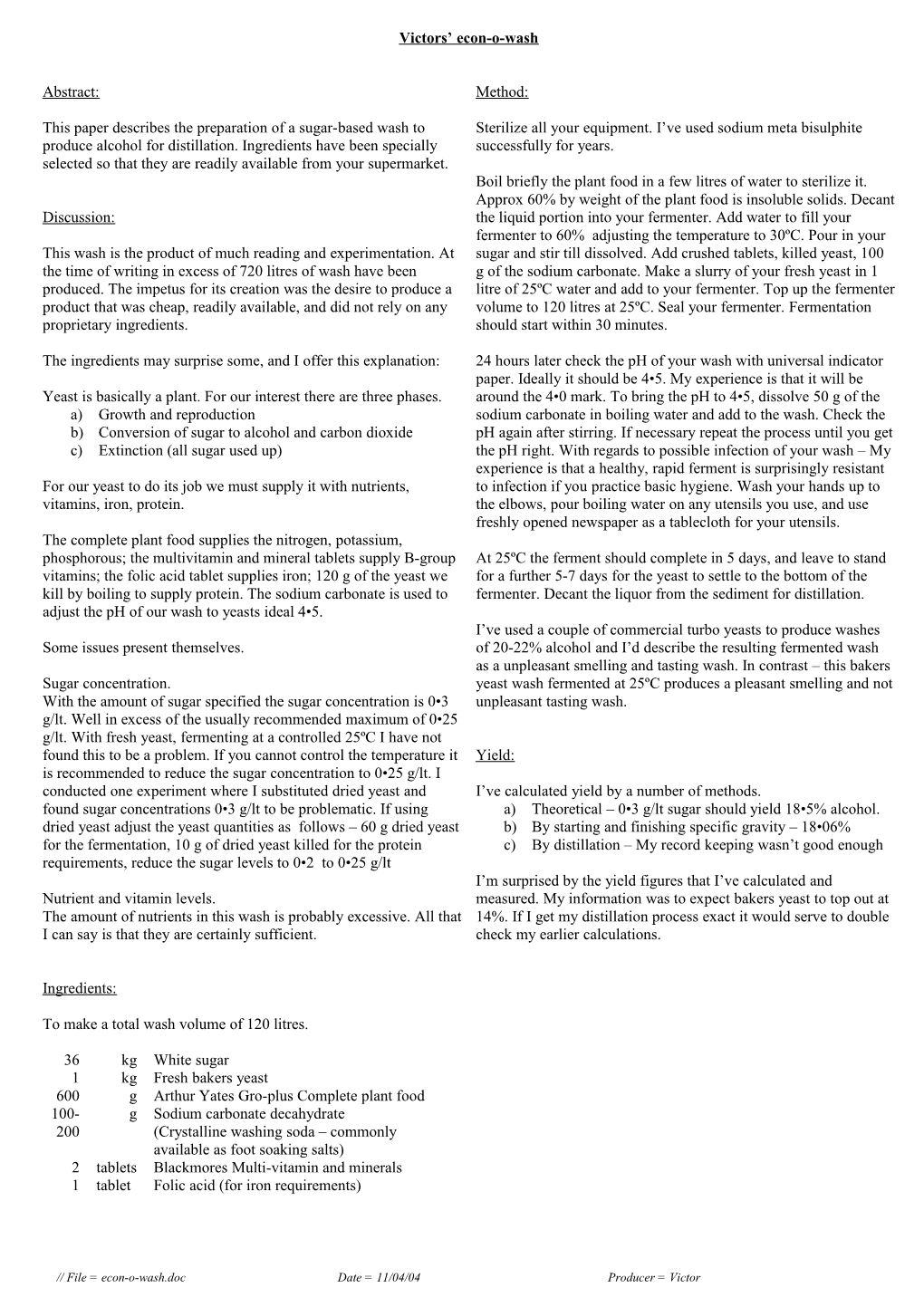Victors’ econ-o-wash
// File = econ-o-wash.docDate = 11/04/04Producer = Victor
Abstract:
This paper describes the preparation of a sugar-based wash to produce alcohol for distillation. Ingredients have been specially selected so that they are readily available from your supermarket.
Discussion:
This wash is the product of much reading and experimentation. At the time of writing in excess of 720 litres of wash have been produced. The impetus for its creation was the desire to produce a product that was cheap, readily available, and did not rely on any proprietary ingredients.
The ingredients may surprise some, and I offer this explanation:
Yeast is basically a plant. For our interest there are three phases.
a)Growth and reproduction
b)Conversion of sugar to alcohol and carbon dioxide
c)Extinction (all sugar used up)
For our yeast to do its job we must supply it with nutrients, vitamins, iron, protein.
The complete plant food supplies the nitrogen, potassium, phosphorous; the multivitamin and mineral tablets supply B-group vitamins; the folic acid tablet supplies iron; 120 g of the yeast we kill by boiling to supply protein. The sodium carbonate is used to adjust the pH of our wash to yeasts ideal 4•5.
Some issues present themselves.
Sugar concentration.
With the amount of sugar specified the sugar concentration is 0•3 g/lt. Well in excess of the usually recommended maximum of 0•25 g/lt. With fresh yeast, fermenting at a controlled 25ºC I have not found this to be a problem. If you cannot control the temperature it is recommended to reduce the sugar concentration to 0•25 g/lt. I conducted one experiment where I substituted dried yeast and found sugar concentrations 0•3 g/lt to be problematic. If using dried yeast adjust the yeast quantities as follows – 60 g dried yeast for the fermentation, 10 g of dried yeast killed for the protein requirements, reduce the sugar levels to 0•2 to 0•25 g/lt
Nutrient and vitamin levels.
The amount of nutrients in this wash is probably excessive. All that I can say is that they are certainly sufficient.
Ingredients:
To make a total wash volume of 120 litres.
36 / kg / White sugar1 / kg / Fresh bakers yeast
600 / g / Arthur Yates Gro-plus Complete plant food
100-200 / g / Sodium carbonate decahydrate
(Crystalline washing soda – commonly available as foot soaking salts)
2 / tablets / Blackmores Multi-vitamin and minerals
1 / tablet / Folic acid (for iron requirements)
Method:
Sterilize all your equipment. I’ve used sodium meta bisulphite successfully for years.
Boil briefly the plant food in a few litres of water to sterilize it. Approx 60% by weight of the plant food is insoluble solids. Decant the liquid portion into your fermenter. Add water to fill your fermenter to 60% adjusting the temperature to 30ºC. Pour in your sugar and stir till dissolved. Add crushed tablets, killed yeast, 100 g of the sodium carbonate. Make a slurry of your fresh yeast in 1 litre of 25ºC water and add to your fermenter. Top up the fermenter volume to 120 litres at 25ºC. Seal your fermenter. Fermentation should start within 30 minutes.
24 hours later check the pH of your wash with universal indicator paper. Ideally it should be 4•5. My experience is that it will be around the 4•0 mark. To bring the pH to 4•5, dissolve 50 g of the sodium carbonate in boiling water and add to the wash. Check the pH again after stirring. If necessary repeat the process until you get the pH right. With regards to possible infection of your wash – My experience is that a healthy, rapid ferment is surprisingly resistant to infection if you practice basic hygiene. Wash your hands up to the elbows, pour boiling water on any utensils you use, and use freshly opened newspaper as a tablecloth for your utensils.
At 25ºC the ferment should complete in 5 days, and leave to stand for a further 5-7 days for the yeast to settle to the bottom of the fermenter. Decant the liquor from the sediment for distillation.
I’ve used a couple of commercial turbo yeasts to produce washes of 20-22% alcohol and I’d describe the resulting fermented wash as a unpleasant smelling and tasting wash. In contrast – this bakers yeast wash fermented at 25ºC produces a pleasant smelling and not unpleasant tasting wash.
Yield:
I’ve calculated yield by a number of methods.
a)Theoretical – 0•3 g/lt sugar should yield 18•5% alcohol.
b)By starting and finishing specific gravity – 18•06%
c)By distillation – My record keeping wasn’t good enough
I’m surprised by the yield figures that I’ve calculated and measured. My information was to expect bakers yeast to top out at 14%. If I get my distillation process exact it would serve to double check my earlier calculations.
// File = econ-o-wash.docDate = 11/04/04Producer = Victor
